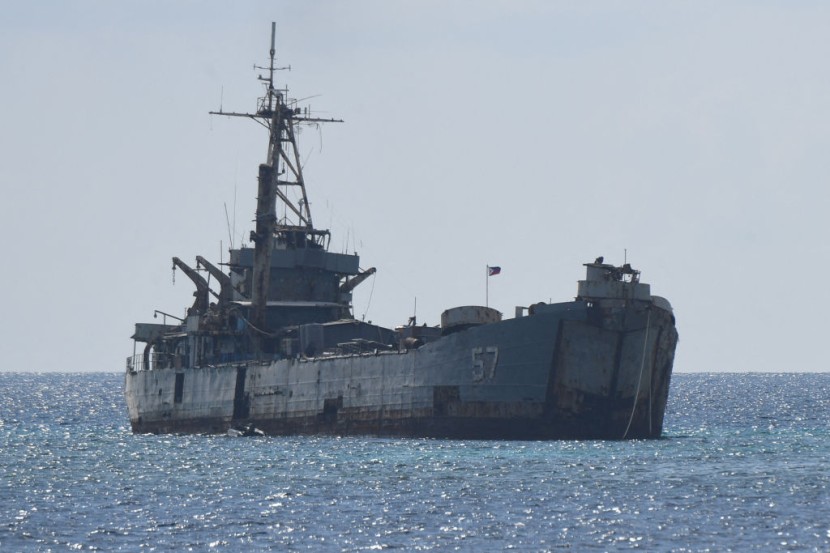
Military officials from the Philippines condemned the Chinese coast guard Sunday (Aug. 6) for the "excessive and offensive" use of water cannons to block Filipino supply boats from delivering food, water, fuel, and replacement troops to the Second Thomas Shoal.
Officials told local media their naval personnel on board two chartered supply boats were cruising toward Second Thomas while being escorted by Philippine Coast Guard ships when a Chinese coast guard vessel approached the flotilla and used a powerful water cannon to block them from entering the shoal, which Beijing also claims to be its own, the Associated Press reported.
In a statement, the Armed Forces of the Philippines said the "excessive and offensive actions" of the Chinese vessel prevented one of the two Filipino boats from unloading its supplies to the BRP Sierra Madre. This marooned vessel remains in commission as an active military outpost manned by marines on a rotation basis.
The Philippine military also called on the Chinese coast guard and Beijing's central military commission to "act with prudence" and take responsibility for preventing miscalculations and accidents endangering human lives.
On the other hand, China reasserted its territorial claim on virtually all of the South China Sea, vowing to continue its law enforcement activity within the region, according to a CNN report.
Intensified Water Claims
The tense incident was the latest in a series of maritime faceoffs between Chinese vessels and the vessels of its neighbors in the disputed waters, one of the world's busiest sea lanes and serves as an Asian flashpoint in the rivalry between Beijing and Washington.
China claims ownership of most of the South China Sea as part of its "Nine-Dash Line" claim. The Philippines, one of the most crucial nations of what geopolitical experts call the "First Island Chain," have asserted the 2016 ruling by The Hague's Permanent Court of Arbitration made any Chinese claim to the waters invalid.
Officials in Manila said the Chinese ship's action was "in wanton disregard of the safety of the people on board" the supply boats, as well as violated international law such as the 1982 United Nations (UN), Convention on the Law of the Sea.
However, military officials did not say if any of its sailors were injured in the incident.
Read Also: Taiwan Detains, Investigates Army Officers Accused of Spying, Leaking Military Secrets to China
International Concern
The US State Department immediately expressed support to the Philippines and renewed its commitment to mutually defend the country and its public vessels, crew, and forces as per its long-running treaty with Manila.
US officials added in its statement that the Chinese vessel's firing of water cannons and "employing [of] unsafe blocking maneuvers...jeopardized" the safety of the Filipino boats and their crew.
While Washington has no claims to any part of the South China Sea, officials have repeatedly told Beijing about the aggressive actions of its warships and fighter jets in patrols and military exercises with regional allies to uphold freedom of navigation and overflight, which it says is in America's national interest.
In response, China warned the US to stop meddling with what it called a purely Asian dispute and warned of unspecified repercussions. They also feared US military presence in the Philippines would provide Washington with military staging grounds and surveillance outposts in the northern Philippines, specifically in the Bashi Channel between the Philippine Mavulis and the Taiwanese Orchid islands.
Australia called the Chinese ship's actions "dangerous and destabilizing," while Japan added they were totally unacceptable.
India, the fourth member of the Quad, has not stated the matter as of this report. However, earlier reports saw New Delhi supporting Manila as a reversal of their position on the 2016 South China Sea Arbitration when Philippine foreign affairs secretary Enrique Manalo visited India last July.

Sierra Madre: Manila's Lone Sentinel
Second Thomas is the shoal where the Philippine Navy ship BRP Sierra Madre was deliberately run aground as a permanent military outpost for Manila in the South China Sea. Prior to her current duties, she was a World War II-era LST-542-class tank landing ship named the USS LST-821 (later named the USS Harnett County). She saw action in the Pacific theater of the war before being decommissioned for the first time in 1946. The LST-821 was recommissioned as the Harnett County in 1966 to serve in US operations in the Vietnam War before she was transferred to the South Vietnamese Navy in 1970 as the RVNS My Tho.
The My Tho was one of the ships that escaped from Saigon after it fell in 1975. A year later, the remnants of the South Vietnamese Navy were transferred to its Philippine counterpart, and My Tho was renamed the BRP Sierra Madre.
As a Philippine ship, the Sierra Madre operated as an amphibious transport vessel for its marine corps until she was intentionally grounded in 1999 at Second Thomas. She remains to be a commissioned Philippine Navy ship and serves as an active military outpost for the archipelago nation in the South China Sea.
Related Article: U.S. Navy Service Member Allegedly Transmitted Sensitive U.S. Military Information to a Chinese Intelligence Officer
© 2025 HNGN, All rights reserved. Do not reproduce without permission.








